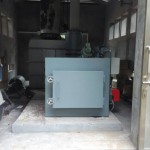50 to 60kg/hr and 100 to 120kg/hr diesel powered incinerator.1. Capability to Incinerate the Following Types of Waste:
Household waste, glass, steel, aluminum cans and window extrudes, steel cans (crushed), timber, tires, white goods, plastic bottles, pressure packs, medical waste and quarantine waste.
2. Required Incinerating Capacity:
Approximately 4,500 tons per year. The incinerator must capable of incinerating type of waste mentioned or any combinations thereof at a rate of 3 tons per hour. The system shall be designed to run for at least five consecutive days non-stop if required.
3. Incinerator Design Requirements:
The system should be simple in design and operation, with minimal electronic components.
The incinerator and associated air pollution control technology will be:
a.Low in use of auxiliary fuel;
b.Low in electrical power use;
c.Require minimal pre-processing of Municipal solid waste;
d.The air pollution system shall comply with EU Waste Incineration Directive 2000/76 and forms part of the whole incinerator setup.
3.1 Specific Data that must be Provided with the Design
3.1.1 Incinerator Data:
a.Batch Load Capacity;
b.Primary chamber design (thickness , diameter, length, insulation , lining, volume hearth area, weight); c. Secondary chamber design (thickness , diameter, length, insulation , lining, volume hearth area, weight);
c.Exhaust stack design (thickness , diameter, lining number of sections, total stack length, height above base, weight);
d.Type and number of auxiliary fuel burners;
e.Fuel requirements – type, quantities;
f.Electrical power usage;
g.Electrical services required;
h.Water requirements – quantities;
i.Any other input requirements and consumables ;
j.Temperatures to be achieved to ensure suitable destruction of waste and comply with required air pollution control standards (EU Waste Incineration Directive 2000/76);
k.Residence time to ensure suitable destruction of waste and comply with required air pollution control standards;
l.Potential weight reduction (percentage) of waste;
m.Options to automatically and continuously monitor and record data such as dates, time of day, batch sequential number;
n.A temperature or visual indicator to display heat status of equipment; and
o.Details on graphic displays and / or computer recording devices.
3.1.2 Air Pollution Control System Data
a.The type of air pollution control equipment selected will comply with EU WID Waste Incineration
b.Directive 2000/76;
c.Details on the gas cleaning systems to enhance the removal of fine particles, acid gases and heavy
d.metals;
e.Details on components, such as:
quencher;
condenser / absorber;
venturi scrubber;
entrainment separator and
emissions stack(s).
Electrical power usage;
f.Any other input requirements and consumables (e.g. lime);
g.Details on graphic displays and / or computer recording devices;
h.Environmental requirements – The system would have the capacity / ability to comply with relevant air quality criteria; i.e.EU Waste Incineration Directive 2000/76. (or similar standards and criteria acceptable to the Australian Commonwealth Government Department of the Environment);
i.Specify air pollution parameters that are monitored.
3.1.3 Site Requirements for the Incinerator
a.Total land area dimentions;
b.Infrastructure required ( water supply, electricity supply drainage); and
c.Any specific environmental or climatic/meteorological factors that needs consideration.
3.1.4 Housing Requirements and Design
a.Details on requirements for a secure enclosure for the incinerator and associated air pollution control system. The enclosure will be designed to achieve occupational health and safety requirements such as: a. Free space is available on all sides and heat radiation is kept at a minimum giving the operators an:
b.easy workable environment and ventilation;
c.There are secure storage facilities for waste;
d.There are measures to avoid vermin and pests;
e.The materials will be of sufficient structural thickness for safety and to withstand sea corrosion.
4. Training, Maintenance And Instruction Manuals
4.1 Maintenance Manuals
Provide details on maintenance requirements, such as:
a.General cleaning and maintenance – frequency, skills / technical expertise required;
b.Expected life span of parts and the system as a whole;
c.Expected frequency of the need for replacement of parts;
d.Availability of parts and location of suppliers;
e.Frequency of need for major overhauls; and
f.Estimated down time required for general maintenance and major overhauls.an incinerator for our dead animals in the farm particularly chicken.






